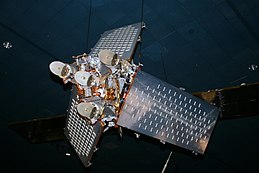Iridium NEXT

Replica of a 1st-generation Iridium satellite
|
|
| Manufacturer | Motorola (Original constellation) - Thales Alenia Space (NEXT constellation) |
|---|---|
| Country of origin | USA |
| Operator | Iridium Communications |
| Applications | communications |
| Specifications | |
| Bus | LM-700(Original) - EliteBus1000(NEXT) |
| Launch mass | 689 kilograms (1,519 lb) |
| Power | 2 deployable solar panels+batteries |
| Regime | Low Earth Orbit |
| Production | |
| Status | In Service |
| Built | 98 |
| Launched | 95 (Original) - 10 (NEXT) |
| Operational | 72 (66 in active service 6 spares) |
| First launch | Iridium 4,5,6,7,8 on 5 May 1997 |
| Last launch | 14 January 2017 |
The Iridium satellite constellation is a satellite constellation providing voice and data coverage to satellite phones, pagers and integrated transceivers over the Earth's entire surface. Iridium Communications owns and operates the constellation and sells equipment and access to its services. It was originally conceived by Bary Bertiger, Raymond J. Leopold and Ken Peterson in late 1987 (and protected by patents by Motorola in their names in 1988) and then developed by Motorola on a fixed-price contract from July 29, 1993 to November 1, 1998 when the system became operational and commercially available.
The constellation consists of 66 active satellites in orbit required for global coverage, and additional spare satellites to serve in case of failure. Satellites are in low Earth orbit at a height of approximately 485 mi (781 km) and inclination of 86.4°. Orbital velocity of the satellites is approximately 17,000 mph (27,000 km/h). Satellites communicate with neighboring satellites via Ka band inter-satellite links. Each satellite can have four inter-satellite links: two to neighbors fore and aft in the same orbital plane, and two to satellites in neighboring planes to either side. The satellites orbit from pole to same pole with an orbital period of roughly 100 minutes. This design means that there is excellent satellite visibility and service coverage even at the North and South poles. The over-the-pole orbital design produces "seams" where satellites in counter-rotating planes next to one another are traveling in opposite directions. Cross-seam inter-satellite link hand-offs would have to happen very rapidly and cope with large Doppler shifts; therefore, Iridium supports inter-satellite links only between satellites orbiting in the same direction. The constellation of 66 active satellites has 6 orbital planes spaced 30 degrees apart, with 11 satellites in each plane (not counting spares). The original concept was to have 77 satellites, which is where the name Iridium came from, being the element with the atomic number 77 and the satellites evoking the Bohr model image of electrons orbiting around the Earth as its nucleus. This reduced set of 6 planes is sufficient to cover the entire Earth's surface at every moment.
...
Wikipedia
